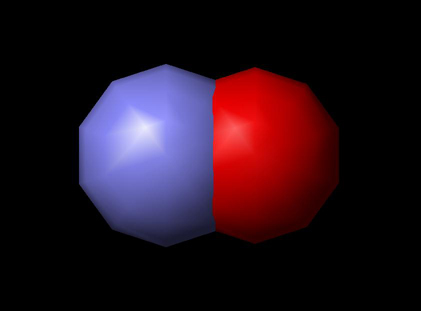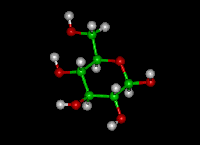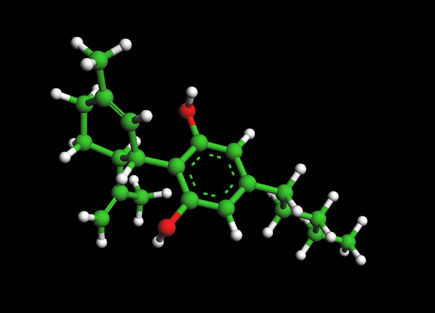The Nitric Oxide Molecule -- A Signaling Molecule

Nitric Oxide Molecule
For 3-D Structure of Nitric Oxide using Jsmol Click
Nitric oxide or Nitrogen monoxide is a chemical compound with chemical formula NO. It has a Molecular mass of 30.0061. Nitric oxide is a free radical, i.e., it has an unpaired electron, which is sometimes denoted by a dot in its chemical formula, i.e., ·NO. Nitric oxide should not be confused with nitrous oxide (N2O), an anesthetic, or with nitrogen dioxide (NO2), a brown toxic gas and a major air pollutant.
Nitric Oxide as a Signaling Molecule in Humans
Nitric is an important signaling molecule in the body of mammals including humans and is an extremely important intermediate in the chemical industry. It is also a toxic air pollutant produced by automobile engines and power plants. The nitric oxide molecule is a free radical, which is relevant to understanding its high reactivity. It reacts with the ozone in air to form nitrogen dioxide, signalled by the appearance of the reddish-brown color.
NO is one of the few gaseous signaling molecules known. It is a key vertebrate biological messenger, playing a role in a variety of biological processes. Nitric oxide, known as the 'endothelium-derived relaxing factor', or 'EDRF', is biosynthesised endogenously from arginine and oxygen by various nitric oxide synthase (NOS) enzymes and by reduction of inorganic nitrate.
The endothelium (inner lining) of blood vessels use nitric oxide to signal the surrounding smooth muscle to relax, thus resulting in vasodilation and increasing blood flow. Nitric oxide is highly reactive (having a lifetime of a few seconds), yet diffuses freely across membranes. These attributes make nitric oxide ideal for a transient signal molecule between adjacent cells and within cells.[3] The production of nitric oxide is elevated in populations living at high-altitudes, which helps these people avoid hypoxia. Effects include blood vessel dilatation, neurotransmission (see Gasotransmitters), modulation of the hair cycle, and penile erections.
Nitroglycerin and amyl nitrite serve as vasodilators because they are converted to nitric oxide in the body. Sildenafil, popularly known by the trade name Viagra, stimulates erections primarily by enhancing signaling through the nitric oxide pathway in the penis.
Nitric oxide (NO) contributes to vessel homeostasis by inhibiting vascular smooth muscle contraction and growth, platelet aggregation, and leukocyte adhesion to the endothelium. In humans, a high-salt intake was demonstrated to attenuate NO production. [1]
Nitric oxide is also generated by macrophages and neutrophils as part of the human immune response. Nitric oxide is toxic to bacteria and other human pathogens. In response, however, many bacterial pathogens have evolved mechanisms for nitric oxide resistance.[4]
Nitric oxide can contribute to reperfusion injury when an excessive amount produced during reperfusion (following a period of ischemia) reacts with superoxide to produce the damaging free radical peroxynitrite. In contrast, inhaled nitric oxide has been shown to help survival and recovery from paraquat poisoning, which produces lung tissue damaging superoxide and hinders NOS metabolism.
Nitric Oxide in Plants
In plants, nitric oxide can be produced by any of four routes: (i) nitric oxide synthase (although the existence animal NOS homologs in plants is debated), (ii) by plasma membrane-bound nitrate reductase, (iii) by mitochondrial electron transport chain, or (iv) by non-enzymatic reactions. It is a signaling molecule, acts mainly against oxidative stress and also plays a role in plant pathogen interactions. Treating cut flowers and other plants with nitric oxide has been shown to lengthen the time before wilting.[5] A biologically important reaction of nitric oxide is S-nitrosylation, the conversion of thiol groups, including cysteine residues in proteins, to form S-nitrosothiols (RSNOs). S-Nitrosylation is a mechanism for dynamic, post-translational regulation of most or all major classes of protein.
Nitric Oxide and Aging
Studies in experimental models and even humans reveal that constitutive production of nitric oxide (NO) is reduced with aging and this circumstance may be relevant to a number of diseases that plague the aging population. "...NO is one of the most important signaling molecules in our body, and loss of NO function is one of the earliest indicators or markers of disease. Clinical studies provide evidence that insufficient NO production is associated with all major cardiovascular risk factors, such as hyperlipidemia, diabetes, hypertension, smoking and severity of atherosclerosis, and also has a profound predictive value for disease progression including cardiovascular and Alzheimers disease. .." see --Nitric oxide and geriatrics: Implications in diagnostics and treatment of the elderly.
Foods that Increase Nitric Oxide
Garlic and Beet Root are very high in nitrates which the body converts to nitric oxide. In addition garlic is high in quercetin which increases NO levels.
A typical garlic clove weighs about 3 grams. A standard clove will produce about 2.5 milligrams to 4.5 milligrams of allicin per gram of fresh weight when crushed. This means you'll get 7.5 milligrams to 13.5 milligrams of allicin from one typical clove that weighs 3 grams.
"... The effect of garlic ingredients or garlic ingredients and antioxidants on human endothelial cell (EC) nitric oxide (NO) production might explain the effects of garlic and vitamin C in lowering marginally high blood pressure..." See: Cellular effects of garlic supplements and antioxidant vitamins in lowering marginally high blood pressure in humans: pilot study
Recent Research on Nitric Oxide
Nitric oxide donors for prostate and bladder cancers: Current state and challenges --"..Nitric oxide (NO) is an endogenous molecule that plays pivotal physiological and pathophysiological roles, particularly in cancer biology. Generally, low concentrations of NO (pico- to nanomolar range) lead to tumor promotion. In contrast, high NO concentrations (micromolar range) have pro-apoptotic functions, leading to tumor suppression, and in this case, NO is involved in immune surveillance. .." read abstract
An Update on Hydrogen Sulfide and Nitric Oxide Interactions in the Cardiovascular System-"...Hydrogen sulfide (H2S) and nitric oxide (NO) are now recognized as important regulators in the cardiovascular system, although they were historically considered as toxic gases. As gaseous transmitters, H2S and NO share a wide range of physical properties and physiological functions: they penetrate into the membrane freely; they are endogenously produced by special enzymes, they stimulate endothelial cell angiogenesis, they regulate vascular tone, they protect against heart injury, and they regulate target protein activity via posttranslational modification. .." read abstract
Role of Nitric Oxide in the Cardiovascular and Renal Systems - "...(NO) has earned repute as a potent vasodilator also known as endothelium-derived vasorelaxant factor (EDRF). .." read abstract
References
- Elizabeth Culotta and Daniel E. Koshland Jr (December 1992). "NO news is good news. (nitric oxide; includes information about other significant advances & discoveries of 1992) (Molecule of the Year).". Science 258 (5090): 1862-1864. 
- Production: Growth is the Norm Chemical and Engineering News, July 1 0, 2006, p. 59.
- Stryer, Lubert (1995). Biochemistry, 4th Edition. W.H. Freeman and Company, pp. 732. ISBN 0-7167-2009-4.
- C. A. Janeway, et al. (2005). Immunobiology: the immune system in health and disease, 6th ed., New York: Garland Science. ISBN 0-8153-4101-6.
- Judy Siegel-Itzkovich. Viagra makes flowers stand up straight. Student BMJ, September 1999.
Further reading
- Butler A. and Nicholson R.; " Life, death and NO." Cambridge 2003. ISBN-13: 978-0-85404-686-7.
- van Faassen, E. E.; Vanin, A. F. (eds); " Radicals for life: The various forms of Nitric Oxide." Elsevier, Amsterdam 2007. ISBN-13: 978-0-444-52236-8.
- F.A. Cotton, G. Wilkinson, C.A. Murillo, M. Bochmann; Advanced Inorganic Chemistry, 6th ed. Wiley-Interscience, New York, 1999.
- K.J. Gupta , M. Stoimenova, and W. M. Kaiser "In higher plants, only root mitochondria, but not leaf mitochondria reduce nitrite to NO, in vitro and in situ" Journal of Experimental Botany 2005 56(420):2601-2609.
- E.Planchet, K.J. Gupta, M .Sonada & W.M.Kaiser (2005) "Nitric oxide emission from tobacco leaves and cell suspensions: rate limiting factors and evidence for the involvement of mitochondrial electron transport"The Plant Journal 41 (5), 732-743.
- Stahr, C.; Stremlau, S. "Formation and possible roles of nitric oxide in plant roots" Journal of Experimental Botany 2006 57(3):463-470.
- Pacher, P.; Beckman, J. S.; Liaudet, L.; “Nitric Oxide and Peroxynitrite: in Health and disease†Physiological Reviews 2007, volume 87(1), page 315-424. PMID 17237348.
Molecules of Life Resources
The Glucose Molecule
Glucose is the most important carbohydrates and is used as a source of energy in animals and plants. Glucose is also one of the main products of photosynthesis and starts respiration..
The Cannabidiol Molecule
Cannabidiol (CBD is the major non-psychoactive component of Cannabis and is being looked at by major drug and consumer companies for various medical and social uses.